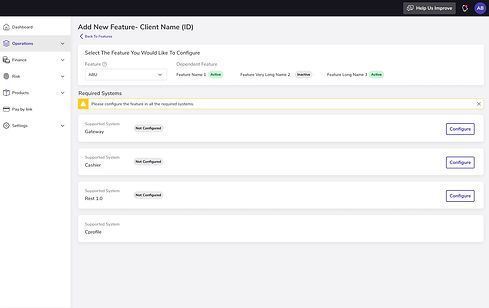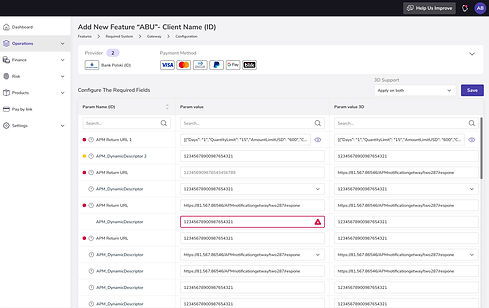Features Management
Feature Configuration Tool in
Fintech Internal System
Overview
Features Management is an internal tool used in a fintech company. It allows users to add, edit, and view features and configure them for each merchant in the system. This system includes various functionalities for handling merchant accounts, transactions, and user management. This project focused on creating a new tool for the Feature Configuration Flow in the internal Merchant Profile System used by employees. The existing system lacked a feature configuration option, requiring the integration team to rely on temporary solutions. The goal was to design a new, user-friendly flow that allows employees to add and configure features across multiple integration systems seamlessly.
ROLE
UX design | Prototyping | Usability Testing | Collaboration
Understanding The Problem
In the current use case, to configure a feature that is supported in different integration systems, the user needs to go to each system separately, which can range from 1 to 4 different systems. To complete this configuration for each feature they want to add, users rely on a documentation file that guides them step by step. Each client has a unique configuration, making the process time-consuming. The current system did not support direct feature configuration. Users responsible for adding and editing features include the Configuration Teams, Implementation Teams, and Tech Support had no structured way to configure integrations, leading to inefficiencies.
User Research
As part of the user research, I conducted qualitative interviews with internal teams who use the system regularly. These conversations helped uncover their current workflow, pain points, and expectations from the new feature. The insights shaped the design direction and ensured we were solving real problems, not just implementing requirements.
Pain Points
No Centralized Configuration- Users do not have a single place within the internal system to add and configure a feature for a client.
Dependency on External Documentation- Users need to understand the configuration process from the documentation before applying it in the system.
Manual & Repetitive Process- Users must navigate between multiple systems separately, increasing workload and the risk of errors.
Goals
-
Centralize feature configuration to allow users to configure integrations from one place.
-
Improve efficiency by reducing the time and steps needed to complete configurations.
-
Enhance user experience by providing a more intuitive and structured workflow.
-
Reduce dependency on external documentation by embedding guidance directly into the system.
-
Ensure flexibility in configuration order and system selection.
Ideation Process
The current system did not support direct feature configuration. Users responsible for adding and editing features include the Configuration Teams, Implementation Teams, and Tech Support had no structured way to configure integrations, leading to inefficiencies. Base on that, I focused on two main pain points:
Multiple Integration Systems
Ensuring users can seamlessly add and configure a feature across multiple integration systems within a single workflow.
Different User Needs
Identified that various users would use this tool differently, leading to the need for structured add, edit, and view feature flows.
Design Process
Initial Design
The first approach used a popup-based flow, allowing users to add and configure a feature within a modal window.
Challenges with the Popup Approach
-
Limited Screen Space – Users struggled with complex tables and configurations in a small modal window.
-
Lack of Context – Switching between integration systems required multiple steps, creating friction.




Second Approach
Full-Screen Flow: Expanded from a popup to a full-page layout for better usability.
Accordion Navigation: Allowed users to select which system to configure first.
System-Specific Configuration: Different sections for each system.




Solution
After identifying the challenges in the accordion-based flow, I implemented a card-based solution to improve clarity and usability.

Prototype
Mockups

Add New Feature
The user clicks on the 'Add Feature' button.

Select Feature
The user selects the feature they want to add to the merchant.

Select Required System
Once the user selects the feature, the supported systems that need to be configured will appear.

Add Integrations
The gateway system requires integration selection before proceeding with the configuration.

Integration Added
The user is now able to select an integration.

Select Integration
Integration selections from different combinations will share the same configuration.

Configuration
Based on the merchant’s name and selected integrations, the system presents the configuration the user needs to add and indicates errors for those that need to be changed.

Configuration Success
Each system saves the configurations separately.
